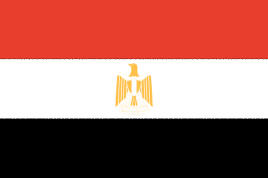 |
 |
Egypt/Italy Tour 2003: Thursday, 17 April 2003
On the train
Awoke early after a not particularly comfortable night (a bit too cold and I lacked some sort of pillow) to find the train travelling through the fertile strip of land adjacent to the Nile. We had passed Luxor and were doing the leg of the journey to Aswan.
The trees consist of numerous pinnate-leaved palms (date palms, I would guess). Also casuarinas, sunflowers, bananas, mangos. At 8 a.m. we arrived at Esna to see mangos and vines just by the platform. We also saw Leucaena leucocephala and Ipomoea carnea.
It's a pity that there is no readily available checklist of Egyptian plants on say the internet; it would have been most useful on this trip. It would have to include cultivated plants as well to be really useful.
8.42: Edfu; 9.45: Kom Ombo and finally at 10.30, Aswan. By 10.45 we were on the bus in the town centre admiring this fountain. The air was very clear - a strong contrast to Cairo - with a strong sun and intense blue skies; quite Zimbabwean really.
Aswan dams
From the town centre we drove to the old dam, which was built in 1902. The bus drove along the crest of the dam and Rob took a picture showing the new "high" dam on the left.
Next stop was at the High Dam monument, a sort of stylised lotus flower.
Images 6 to 11 show the panorama taken from the information point and car park on the High Dam.
Philae temple
Later, we boarded a boat to take us to the temples of Philae, which have been rescued from flooding and moved to Agilika Island.
As we arrived at the island I noticed this plant - is it Calotropis procera? A locally common plant in Zimbabwe too.
The next series of pictures were taken on the island and show Ashraf leading the group around the temple dedicated to Isis. Image 17 shows the open courtyard; 18 has Ashraf in full flow and 19 shows the group sitting in the very welcome shade.
The next two pictures show the group in the courtyard while in 22 the group is entering the temple.
A nilometer - a means of measuring how high the Nile rises and hence how much tax should be paid. The steps lead down to the water's edge. Down at the edge were three plants, which are typically Zimbabwean: Senna occidentalis, Ageratum conyzoides (both are probably worldwide weeds in warmer parts?) and what looked like Pluchea dioscoridis.
The next 3 pictures are: 25: the hypostyle hall; 26: interior detail; 27: exterior walls of the temple and 28: Trajan's kiosk.
On next to Aswan Granite Quarries to see the vast size of Hatchepsut's unfinished obelisk.
Back on the small motor boat for a cruise around Aswan on which we passed the Aga Khan Mausoleum (37) surrounded by desert. We also passed the Aswan Botanical Gardens on one of the islands, which sounded interesting - but there was no time to stop.
We then joined our cruiser, the Nile Goddess. As soon as we were on board, the boat left immediately, travelling the 26 miles north to Kom-Ombo. We had a late but delicious lunch at 4 p.m. and relaxed in our rooms or on deck.
At 6 p.m. in a warm evening we docked at Kom-Ombo (38) and went ashore to see the Temple of Kom-Ombo (39).
Temple of Kom-Ombo
This is unusual because it is jointly dedicated to two gods: Horus the elder (Haroeris) and Sobek the crocodile god (there used to be a lot of crocodiles in the Nile until the end of the 19th century). The Temple is divided into two halves, the left hand side belongs to Horus and the right to Sobek.
By now it was beginning to get dark. The following pictures show sunset over the quay at Kom-Ombo (40), mummified crocodiles in the temple (41), the remains of the original pylon of the temple (42) and then various pictures of the Temple (43 - 46).
Pictures of relief sculptures (47 and 48) and a calendar (49), the nilometer (50) and sarcophagi in the shape of a cartouche (51)
Back on board
There was a meet the crew reception at which an amazing array of soft drink cocktails were served (52 and 53)
... and finally, party time.





















































